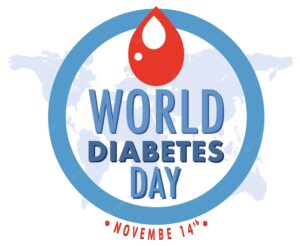 No More Negligence about Diabetes
No More Negligence about Diabetes
Md. Arafat Rahman: Diabetes is a group of metabolic disorders characterized by a high blood sugar level over a prolonged period of time. Symptoms often include frequent urination, increased thirst and increased appetite. If left untreated, diabetes can cause many health complications. Acute complications can include diabetic ketoacidosis, hyperosmolar hyperglycemic state, or death. Serious long-term complications include cardiovascular disease, stroke, chronic kidney disease, foot ulcers, damage to the nerves, damage to the eyes and cognitive impairment.
World Diabetes Day is the primary global awareness campaign focusing on diabetes mellitus and is held on 14 November each year. Led by the International Diabetes Federation (IDF), each World Diabetes Day focuses on a theme related to diabetes. Type-2 diabetes is largely preventable and treatable non-communicable disease that is rapidly increasing in numbers worldwide. Type 1 diabetes is not preventable but can be managed with insulin injections. While the campaigns last the whole year, the day itself marks the birthday of Frederick Banting who, along with Charles Best and John James Rickard Macleod, first conceived the idea which led to the discovery of insulin in 1922.
Diabetes is due to either the pancreas not producing enough insulin, or the cells of the body not responding properly to the insulin produced. There are three main types of diabetes mellitus:
- a) Type 1 diabetes results from failure of the pancreas to produce enough insulin due to loss of beta cells. This form was previously referred to as “insulin-dependent diabetes mellitus” or “juvenile diabetes”. The loss of beta cells is caused by an autoimmune response.[13] The cause of this autoimmune response is unknown.
- b) Type 2 diabetes begins with insulin resistance, a condition in which cells fail to respond to insulin properly. As the disease progresses, a lack of insulin may also develop. This form was previously referred to as “non insulin-dependent diabetes mellitus” or “adult-onset diabetes”. The most common cause is a combination of excessive body weight and insufficient exercise.
- c) Gestational diabetes is the third main form, and occurs when pregnant women without a previous history of diabetes develop high blood sugar levels.
Type 1 diabetes must be managed with insulin injections. Prevention and treatment of type 2 diabetes involves maintaining a healthy diet, regular physical exercise, a normal body weight, and avoiding use of tobacco. Type 2 diabetes may be treated with medications such as insulin sensitizers with or without insulin. Control of blood pressure and maintaining proper foot and eye care are important for people with the disease. Insulin and some oral medications can cause low blood sugar. Weight loss surgery in those with obesity is sometimes an effective measure in those with type 2 diabetes. Gestational diabetes usually resolves after the birth of the baby.
As of 2019, an estimated 463 million people had diabetes worldwide with type 2 diabetes making up about 90% of the cases. Rates are similar in women and men. Trends suggest that rates will continue to rise. Diabetes at least doubles a person’s risk of early death. In 2019, diabetes resulted in approximately 4.2 million deaths. It is the 7th leading cause of death globally. The classic symptoms of untreated diabetes are unintended weight loss, increased urination), increased thirst and increased hunger. Symptoms may develop rapidly in type 1 diabetes, while they usually develop much more slowly and may be subtle or absent in type 2 diabetes.
Several other signs and symptoms can mark the onset of diabetes although they are not specific to the disease. In addition to the known symptoms listed above, they include blurred vision, headache, fatigue, slow healing of cuts, and itchy skin. Prolonged high blood glucose can cause glucose absorption in the lens of the eye, which leads to changes in its shape, resulting in vision changes. Long-term vision loss can also be caused by diabetic retinopathy. A number of skin rashes that can occur in diabetes are collectively known as diabetic dermadromes.
Low blood sugar or hypoglycemia is common in people with type 1 and also in type 2 diabetes depending on the medication being used. Most cases are mild and are not considered medical emergencies. Effects can range from feelings of unease, sweating, trembling, and increased appetite in mild cases to more serious effects such as confusion, changes in behavior such as aggressiveness, seizures, unconsciousness, and rarely permanent brain damage or death in severe cases. Rapid breathing, sweating, and cold, pale skin are characteristic of low blood sugar but not definitive. Mild to moderate cases are self-treated by eating or drinking something high in rapidly absorbed carbohydrates. Severe cases can lead to unconsciousness and must be treated with intravenous glucose or injections with glucagon.
Insulin is the principal hormone that regulates the uptake of glucose from the blood into most cells of the body, especially liver, adipose tissue and muscle, except smooth muscle, in which insulin acts. Therefore, deficiency of insulin or the insensitivity of its receptors plays a central role in all forms of diabetes mellitus. There is no known preventive measure for type 1 diabetes. Type 2 diabetes, which accounts for 85–90% of all cases worldwide, can often be prevented or delayed by maintaining a normal body weight, engaging in physical activity, and eating a healthy diet.
Higher levels of physical activity like more than 90 minutes per day reduce the risk of diabetes by 28%. Dietary changes known to be effective in helping to prevent diabetes include maintaining a diet rich in whole grains and fiber, and choosing good fats, such as the polyunsaturated fats found in nuts, vegetable oils, and fish. Limiting sugary beverages and eating less red meat and other sources of saturated fat can also help prevent diabetes. Tobacco smoking is also associated with an increased risk of diabetes and its complications, so smoking cessation can be an important preventive measure as well.
Diabetes management concentrates on keeping blood sugar levels as close to normal, without causing low blood sugar. This can usually be accomplished with dietary changes, exercise, weight loss, and use of appropriate medications, insulin, oral medications. Learning about the disease and actively participating in the treatment is important, since complications are far less common and less severe in people who have well-managed blood sugar levels. Attention is also needs to paid to other health problems that may accelerate the negative effects of diabetes.
These include smoking, high blood pressure, metabolic syndrome obesity, and lack of regular exercise. Specialized footwear is widely used to reduce the risk of ulcers in at-risk diabetic feet although evidence for the efficacy of this remains equivocal. The principles of managing diabetes may be similar across the general population with diabetes, however some considerations may need to be addressed when tailoring intervention, mainly in special populations.
Author: Md. Arafat Rahman is a columnist and services holder at Southeast University. He can be reached at arafatrahman373@gmail.com




